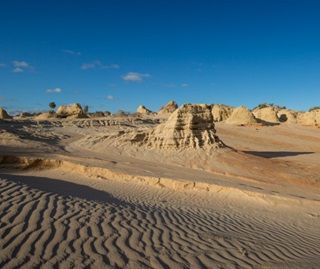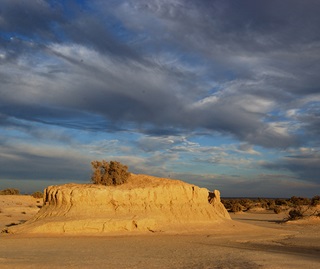 This World Heritage-listed property is a semi-arid region of 2400 square kilometres. It includes several dried lake beds amongst a landscape of bluebush/saltbush, mallee trees, cypress pine and grasses. Fifty thousand years ago the lakes contained fresh water. They started drying up about 19,000 years ago.
This World Heritage-listed property is a semi-arid region of 2400 square kilometres. It includes several dried lake beds amongst a landscape of bluebush/saltbush, mallee trees, cypress pine and grasses. Fifty thousand years ago the lakes contained fresh water. They started drying up about 19,000 years ago.
Aboriginal people have lived in the Willandra Lakes Region for at least 50,000 years. Three Aboriginal communities are the traditional owners of this land – the Barkandji/Paakantyi, Mutthi Mutthi and Ngiyampaa people.
The region is an ancient landscape and supports an ancient culture that continues to exist today. For example:
- The cremated remains of Mungo Woman were found in the dunes of Lake Mungo. The cremation site is at least 42,000 years old, the oldest known in the world.
- The burial site of Mungo Man. This site is a few hundred metres from Mungo Woman’s and is thought to be a similar age. Mungo Man’s remains and those of other Aboriginal people from Willandra Lakes were returned to the area’s traditional owners – the Barkandji/Paakantyi, Mutthi Mutthi and Ngiyampaa people – in 2017.
- The largest group of fossil human footprints in the world occur in the Willandra Lakes Region. The 500 fossilised human footprints were made by adults, teenagers and children in wet clay and are around 20,000 years old.
- Several well-preserved fossils of giant marsupials have been found in the region.
The region also has some striking geological formations, such as the eroded dune system called the Walls of China.
World heritage listing
 The Willandra Lakes Region was added to the World Heritage List in 1981. The boundary of the original listing was modified in 1995 to better define the area containing World Heritage values.
The Willandra Lakes Region was added to the World Heritage List in 1981. The boundary of the original listing was modified in 1995 to better define the area containing World Heritage values.
The Willandra Lakes Region includes national park (Mungo National Park – 30%) and pastoral leases (grazing properties – 70%).
Mungo National Park is managed by the NSW National Parks and Wildlife Service and the grazing properties are managed by leaseholders.
The Australian Government, as signatory to the World Heritage Convention, works with state agencies through the Department of Environment and Energy to manage World Heritage-listed areas.
Management committees
Representatives of New South Wales and Australian Government agencies participate in an intergovernmental management committee. This committee maintains communication between relevant agencies and governments and determines policy directions for this World Heritage area.
An advisory committee, an Aboriginal advisory group and a landholders group help us manage this region.


